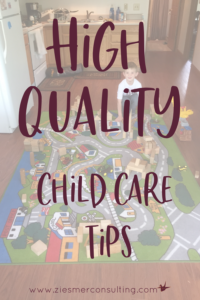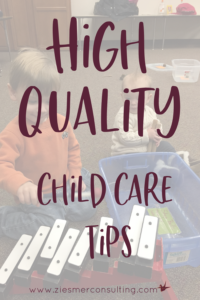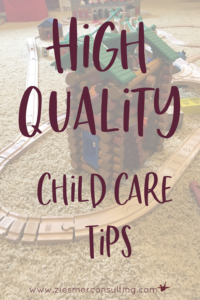We often hear the term high quality when it comes to child care, but what does it really mean? There are a few different definitions but what it really means is that the child care provider makes choices that are best for the children they serve. This can look different in d ifferent centers or homes and it can look different in different parts of the country. But the core concept remains- they make decisions based on what is best for children. Below I have written out some tips for both parents and providers to refer to when it comes to high quality child care.
ifferent centers or homes and it can look different in different parts of the country. But the core concept remains- they make decisions based on what is best for children. Below I have written out some tips for both parents and providers to refer to when it comes to high quality child care.
High Quality Child Care Tips
- Is the program well organized? I don’t mean are the toys all put away neatly with everything in it’s place. That is actually a warning sign. What I mean is, are there policies and procedures in place to ensure the safety of the children are being thought of? Is there a daily or weekly schedule? What is the routine? Are activities well thought out and planned ahead of time?
- What are the qualifications of the person providing care? Do they have an understanding of child development? If there are multiple age children, can they keep all of the ages engaged and active? A good provider does not necessarily need to have a Phd. in child development but, they do need to have a basic understanding of brain development and how children learn. They need to be able to provide a variety of stimulating experiences and opportunities for children to explore.
- A high quality child care will use positive guidance. You will see care givers role model appropriate behavior. Children will learn how to use their words. They will learn to self regulate their emotions in a safe and respectful way. Young children are naturally self centered and often are not aware that their actions, desires and behaviors affect others. A good provider will help them learn this important social skill. The ability to have healthy social interactions is a skill that will last a lifetime.
Bonus Tips
- Does the provider foster strong partnerships with families? Families are a child’s foundation. When providers build strong partnerships with families it shows children they are safe. Children learn better when they feel safe, valued and loved. By building relationships with families providers and parents join forces to provide that type of security to enrich the child’s emotional development.
- What do the caregiver/child interactions look like? Is the provider getting down at eye level to speak to the child? Do they use a calm steady voice? Does the provider ask open ended questions to encourage language use? Are they on the floor facilitating the children’s play? Do they follow the interests of the children?
High Quality Child Care in Action
I’ll give you an example:
Three or four children are building with wooden blocks in the middle of the room. Today is the third day in a row that they have been busy using the blocks to build roads and bridges for their toy cars. The provider notices this and that evening after the children leave she digs in her cupboard. She finds some pieces of plastic PVC pipe, some cone shaped foam pieces and some black electrical tape. She uses the tape to mark a road on the floor and puts the rest of the items in the bin with the blocks and cars. When the children come the next day they are excited to see the new items. They happily spend the day playing. They continue building new structures and driving their vehicles on the roads and through the tunnels.
What Children are Learning
The children are learning cooperation by working together. They also learn engineering by building structures that stay standing under pressure and math by figuring out how things all fit together. The provider facilitated their play by observing what they were interested in and bringing in additional props to help extend their learning.
Conclusion
These are just a few basic examples of what high quality child care could look like and what kinds of things both parents and providers should be thinking about. There are many different scenarios where things could look completely  different. When children have a high level of social/emotional needs and need additional adult support this could look very different. When a child is having a hard day because they are tired or don’t feel well even the best planned activities are going to go by the wayside. Look at how a provider handles all the many scenarios and situations that arise when working with children. This is a sign of whether they have the temperament and the skills to provide care and facilitate a child’s learning and development over time.
different. When children have a high level of social/emotional needs and need additional adult support this could look very different. When a child is having a hard day because they are tired or don’t feel well even the best planned activities are going to go by the wayside. Look at how a provider handles all the many scenarios and situations that arise when working with children. This is a sign of whether they have the temperament and the skills to provide care and facilitate a child’s learning and development over time.
A good provider has the heart for the work as well as the initiative to stay up to date with current research when it comes to high quality. All children deserve to be loved, nurtured and taught by providers who care about them and who care about the process of learning.
For more tips click here and here.
Don’t forget to join me on facebook!







Leave a Reply